For many years now I have worked with children with special needs. I have worked with children with Down Syndrome, Autism, mental retardation, Fragile X, ADHD, Fetal Alcohol Syndrome, and a handful of other “syndromes.” I have worked with children who are gifted, deaf, blind, and have even worked with a child with juvenile diabetes. I have never, in my 15 years of working with children worked with a child who had juvenile arthritis.
In fact, I had never even HEARD of juvenile arthritis.
Then in the beginning of November of 2010 I noticed my almost 2 year old daughter was limping one morning. And then the next morning. But she was always fine after breakfast and since I am generally a pretty laid back mama, I didn’t call the doctor. I mean, she fine fine after a while, so she probably just pulled a muscle, right?
Well the limp came and went and then the day before my baby girls second birthday she slips out of bed that morning and she can barely walk.
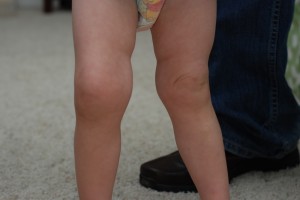
My husband goes to change her diaper and I hear her scream out and cry. My husband had noticed that she wasn’t extending her right knee, so he tried to extend it for her. After she calmed down, we removed her pants to find a very swollen knee.
It was a Saturday. Off to the pediatrician we went. Long story short, over the next few weeks our daughter endured several doctor visits, x-rays, and more lab work than any 2 year old should have to suffer through. We were so blessed to have an amazing medical team that wasted no time in referring us on to the “big guns” at Stanford when the swelling was not reduced with the use of Motrin around the clock for 10 days. Two weeks later E was diagnosed with Oligo-articular Juvenile Arthritis.
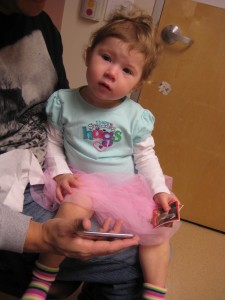
At the doctor on her second birthday.
I’m sorry, what? Can you repeat that please? My two year old has arthritis!? Isn’t arthritis an old person’s disease!?
Yup. That is what I was thinking when I first started consulting Dr. Google (don’t you consult him first too?). How can my kid have arthritis?
Well as it turns out, there are different types of arthritis. The word arthritis simply means “joint inflammation.” But the type we usually think of when we hear the term arthritis is Osteoarthritis: inflammation and degeneration of the joint caused by wear and tear. You know, the kind old people get.
No, my daughter has juvenile arthritis (aka juvenile idiopathic arthritis and formally known as juvenile rheumatoid arthritis). It is a chronic life long auto immune disease with no cure.
Yes, this is an auto immune disease folks. My daughter’s own immune system, the thing that is supposed to keep her healthy and safe from disease, is actually malfunctioning and mistaking her joints as the enemy and attacking them. This leads to swollen, painful joints.
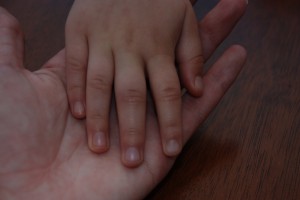
E’s swollen fingers due to her JA
According to the Arthritis Foundation: “Arthritis effects the musculoskeletal system and specifically the joints – where two or more bones meet. Arthritis-related joint problems include pain, stiffness, inflammation and damage to joint cartilage (the tough, smooth tissue that covers the ends of the bones, enabling them to glide against one another) and surrounding structures. Such damage can lead to joint weakness, instability and visible deformities that, depending on the location of joint involvement, can interfere with the most basic daily tasks such as walking, climbing stairs, using a computer keyboard, cutting your food or brushing your teeth.” (www.arthritis.org)
This may not sound severe to you, but let me tell you that this disease can do serious damage to the body, and in severe cases, can actually be deadly. My daughter’s bones in her knee already have over grown a bit from all the inflammation (called bony over growth). Have you ever seen the fingers of an older person that are gnarled from years of arthritis? This can happen to children who suffer from this disease if it is not properly treated.
Treatment. What is the treatment, you may ask?
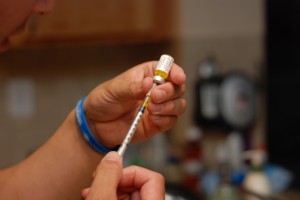
My husband drawing out the Methotrexate, a chemo agent, to treat E’s JA
Believe it or not, the treatment for this disease involves some pretty hard core medications. Some are the same ones used for chemotherapy (but in lower doses). In fact, our daughter was om one of these medications. Some children do not respond to these medications alone (which, by the way, are typically given via injection weekly at home. Yes, we have to give our daughter shots) and these children often have to move on to even more aggressive medications that are typically given via infusion every few weeks or so. The goal of these medications is to suppress the immune system just enough that it stops attacking itself.
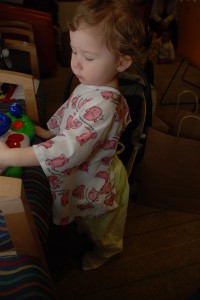
E on the day of her injection. Isn’t her little gown adorable?
Another common treatment is steroid injections directly into the affected joint(s). Our daughter underwent this procedure in January of this year in her affected knee. Because of her age, it was necessary to have her put under general anesthesia. Going under is scary for anyone…but let me tell you it is really scary having to put your child under.We also found out that toddlers tend to have the worst reactions when coming out of anesthesia. E was no exception. The poor girl screamed for three hours straight after her procedure. It was heartbreaking.
The good news, was that the injection was a success! It eliminated the inflammation and as I write this, her knee has been inflammation free for nearly 8 months!

Let’s hope her eyes stay healthy
However, JA doesn’t limit itself to joints. If it isn’t enough that the immune system attacks its own joints, many children with JA are at a high risk for a condition called Uveitis, which is inflammation in the eyes that often has no symptoms until damage has been done. Therefore, our daughter must be followed closely by a pediatric ophthalmologist to ensure her confused immune system does not also attack her eyes.
I’ll tell you, it is no fun watching your child hobble around like an old lady and it is a little sad when your child can’t make a full fist because her knuckles are too swollen. So my family and I are working hard to do what we can to educate others about this silent disease and try to help raise money to fund research for better treatments and hopefully a cure. Because believe it or not, Juvenile Arthritis is one of the most common childhood diseases…it is more common than juvenile diabetes and sickle cell anemia…though more people are familiar with those diseases.
There are nearly 300,000 children in the US who suffer from a form of Juvenile Arthritis.
And there is no cure for JA. Children also do not just grow out of it. (Darn Dr. Google was very wrong about that…). The hope is to get the disease into remission.
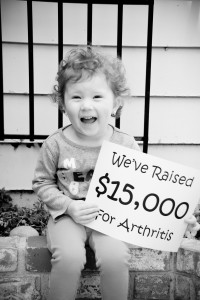
E, the day we hit the $15,000 mark on fundraising
Every year we help support the mission of the Arthritis Foundation by raising funds and participating in the Arthritis Walk. Over the last 3 walks we have raised over $30,000 for Arthritis research and education. We are devoted to make sure our baby girl, and others like her, will ALWAYS be able to dance.

Because really, doesn’t she deserve a cure?
In addition to the Arthritis Walk, the Arthritis Foundation puts on all kinds of other fundraisers all over the country. Here in California, the California Coast Classic is yet another wonderful event to help raise funds for arthritis research, education, and community programs. The CCC is an 8-day, 525 mile ride from San Francisco to Los Angeles. Esella was an honoree at the 2011 CCC ride along with 7 other youth who suffer from this disease.
Here is the video I made for our first Arthritis Walk…take a few minutes to become more educated about this disease.
In 2013, we celebrated 6 months off medications where Esella was not experiencing any JA symptoms. That all changed that fall when her JA returned. Because of some pretty hefty side effects, we chose to not start her back on the medication that got her into this remission (methotrexate) but rather a different type of medication, called a biologic. As I type this in late September, we are expected to get training on how to administer her new medication soon so we can hopefully get her into another remission.
For more information on Juvenile Arthritis, including symptoms, please check out this page by the Arthritis Foundation:
If you have a child who has been diagnosed with juvenile arthritis and are looking for support, please email me at katie@playingwithwords365.com as I’d love to get you in touch with some supportive JA families!